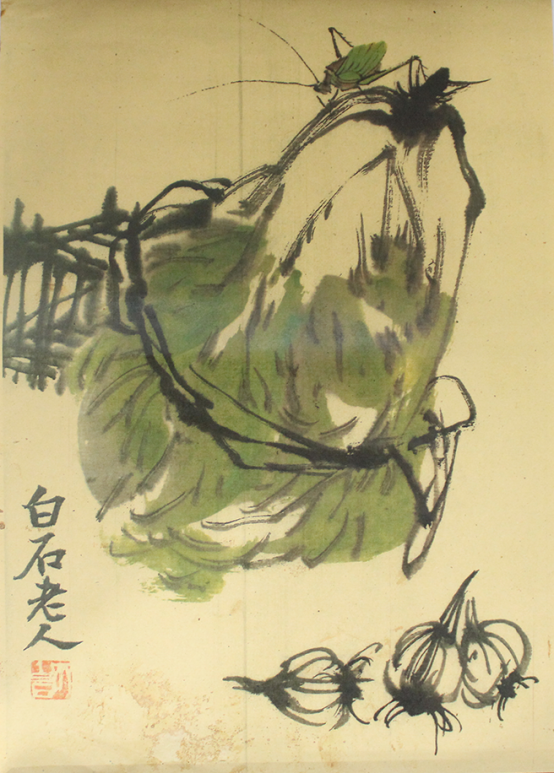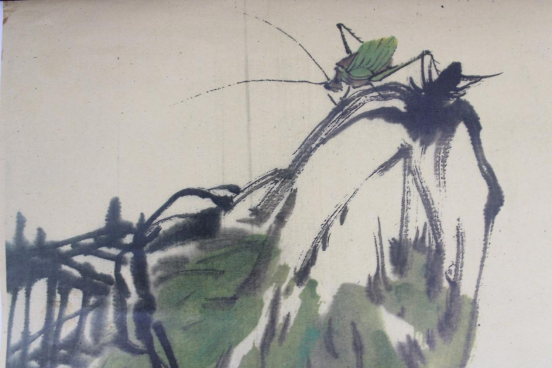Boutique Recommendation - "Qi Baishi's" Hundred Treasures Map "
齐白石(1864年1月1日─1957年9月16日),祖籍安徽宿州砀山,生于湖南长沙府湘潭(今湖南湘潭)人。原名纯芝,字渭青,号兰亭。后改名璜,字濒生,号白石、白石山翁、老萍、饿叟、借山吟馆主者、寄萍堂上老人、三百石印富翁。
Qi Baishi (January 1, 1864- September 16, 1957), originally from Dangshan, Suzhou, Anhui, was born in Xiangtan, Changsha Prefecture, Hunan (now Xiangtan, Hunan). Originally named Chunzhi, with the name Weiqing and the name Lanting. Later, it was renamed Huang, with the character "Biansheng" and the names "Baishi", "Baishi Shanweng", "Laoping", "Hungry Old Man", "Jieshan Yin Guan Zhu", "Jiping Tang Shang Lao Ren", and "Three Hundred Stone Seal Rich Man".
是近现代中国绘画大师,世界文化名人。早年曾为木工,后以卖画为生,五十七岁后定居北京。擅画花鸟、虫鱼、山水、人物,笔墨雄浑滋润,色彩浓艳明快,造型简练生动,意境淳厚朴实。所作鱼虾虫蟹,天趣横生。齐白石书工篆隶,取法于秦汉碑版,行书饶古拙之趣,篆刻自成一家,善写诗文。曾任中央美术学院名誉教授、中国美术家协会主席等职。代表作有《蛙声十里出山泉》《墨虾》等。
He is a master of modern Chinese painting and a world-renowned cultural figure. In his early years, he worked as a carpenter and later made a living selling paintings. At the age of 57, he settled in Beijing. Proficient in drawing flowers and birds, insects and fish, landscapes, and characters, with powerful and moist strokes, bright and vibrant colors, concise and vivid shapes, and a simple and simple artistic conception. The fish, shrimp, insects, and crabs created are full of natural charm. Qi Baishi, a calligrapher of the Qin and Han dynasties, adopts the seal script script, which is based on the inscriptions of the Qin and Han dynasties. The running script has the charm of being ancient and clumsy, and the seal carving has its own style, making it adept at writing poetry and prose. Formerly served as honorary professor at the Central Academy of Fine Arts and chairman of the Chinese Artists Association. Representative works include "The Sound of Frogs Leaving the Spring from Ten Miles" and "Ink Shrimp".
白菜是我国原产蔬菜,有悠久的栽种历史。白菜在民间俗称“百姓之菜”,霜打后的白菜,味道特别鲜美。我国不少地区的老百姓在过春节的时候,都要吃两道家常菜,即长叶白菜和青菜。寓意天长地久,清清白白。
Chinese cabbage is an indigenous vegetable in China with a long history of cultivation. Chinese cabbage is commonly known as "the dish of the people" in the folk, and after being frosted, it has a particularly delicious taste. During the Spring Festival in many regions of our country, people usually eat two home cooked dishes, namely long leaved cabbage and green vegetables. The meaning is eternal, pure and white.

白菜,谐音“百财”,寓意财源滚滚,同时它的菜叶是青色,菜帮为白色,象征清清白白,故成为文人画家们喜欢表现的一个题材。
Cabbage, homophonic for "hundred treasures", symbolizes the rolling source of wealth. At the same time, its leaves are green, and the vegetable side is white, symbolizing purity and whiteness. Therefore, it has become a favorite theme for literati and painters to express.
在白菜国画中,白菜头通常被画得饱满、肥大,寓意着家庭的财源丰盛、充裕。葱则象征着家庭的吉祥和团圆,蘑菇则寓意着富贵和吉祥。而这些元素组合在一起,形成了一个充满生命力、充满财富和好运的图像。
In traditional Chinese cabbage paintings, the head of the cabbage is usually painted plump and plump, symbolizing the wealth and abundance of the family. Scallions symbolize the auspiciousness and reunion of families, while mushrooms symbolize wealth and auspiciousness. And these elements are combined to form an image full of vitality, wealth, and good luck.
此外,白菜国画还有一个有趣的传说。相传,清朝时期的一个官员因为收受贿赂被罚去种地,他种了一种白菜,但结果却是一年比一年丰收,最后他还清了罪恶并成了富翁。这个传说也进一步加强了白菜国画的吉祥寓意,使其成为一个富有文化内涵的装饰品。
In addition, there is an interesting legend about Chinese cabbage painting. Legend has it that during the Qing Dynasty, an official was punished for taking bribes to farm. He planted a type of cabbage, but the result was a bumper harvest year by year. In the end, he paid off his sins and became a wealthy man. This legend further strengthens the auspicious meaning of Chinese cabbage painting, making it a rich cultural decoration.

白石老人一生喜画白菜,并且非常愿意向大家告白他的农家身份,他曾在《白菜》上题诗句:“不独老萍知此味,先人三代咬其根。”又题:“牡丹为花之王,荔枝为果之先,独不论白菜为菜之王,何也?”可见,在齐白石眼里,白菜的地位非同一般,画家是将白菜视为“菜王”看待的。
Baishi Old Man loved to paint cabbage throughout his life and was very willing to confess his rural identity to everyone. He once wrote a poem in "Cabbage": "Not only did Lao Ping know this flavor, but three generations of ancestors bit its roots." He also wrote: "Peony is the king of flowers, lychee is the first of fruits, and regardless of whether cabbage is the king of vegetables, why?" It can be seen that in Qi Baishi's eyes, the position of cabbage is extraordinary, and the painter regards cabbage as the "king of vegetables".
齐白石笔下的白菜特别的鲜活,处处都透露出旺盛的生命活力和浓郁的生活气息。老人用他那简练的笔墨,诙谐有趣的画面语言,为我们展现了一幅幅饱含别样情思的生动图画。可以说,把白菜画出了名,是从齐白石这里开始的....
The cabbage depicted by Qi Baishi is particularly fresh, revealing a vibrant vitality and rich atmosphere of life everywhere. The old man used his concise brushstrokes and witty and interesting language to present us with vivid pictures full of unique emotions. It can be said that the naming of cabbage began from Qi Baishi
齐白石一生热衷画白菜,他画的白菜独树一帜,将普通的白菜画出了新的境界。齐白石画白菜,笔墨老辣,遒劲有力,墨色多变,构图巧妙,同时在题款上更赋予白菜以新的含义。齐白石以做人清白自居,有时还加入对社会的现实批判,使自己的绘画更具有了文人画的价值,将画家的人生观、价值观都注入到绘画中,这是齐白石白菜题材绘画的独特所在。
Qi Baishi was passionate about painting cabbage throughout his life, and his paintings of cabbage were unique, taking ordinary cabbage to a new level. Qi Baishi painted Chinese cabbage with spicy and powerful strokes, diverse ink colors, and clever composition. At the same time, he gave Chinese cabbage a new meaning in the title. Qi Baishi prides himself on being innocent and sometimes adds criticism of social reality, making his paintings more valuable as literati paintings. He infuses the painter's philosophy and values into his paintings, which is the unique feature of Qi Baishi's cabbage themed paintings.
齐白石的“百财图”还具有很高的收藏价值和投资价值。随着白石老人艺术地位的不断提高,他的作品越来越受到人们的关注和追捧。这幅齐白石的“百财图”作为齐白石的代表之作,其价值不言而喻。同时,这幅画还具有很强的历史价值和文化价值,是研究齐白石的艺术创作和生平的重要资料。因此,收藏这幅“百财图”不仅能够给人们带来美的享受,还能够带来丰厚的回报。
Qi Baishi's "Hundred Treasures Map" also has high collection and investment value. With the continuous improvement of the artistic status of Baishi Old Man, his works are increasingly receiving people's attention and pursuit. As a representative work of Qi Baishi, the "Hundred Wealth Map" of Qi Baishi is of self-evident value. At the same time, this painting also has strong historical and cultural value, and is an important material for studying Qi Baishi's artistic creation and life. Therefore, collecting this "Hundred Wealth Map" can not only bring people beautiful enjoyment, but also bring rich rewards.
齐白石的“百财图”是一幅具有很高艺术价值、历史价值和文化价值的作品。它以其独特的艺术风格、深厚的文化内涵和精湛的技艺,成为了中国画坛的经典之作。这幅画具有很强的收藏价值和投资价值,是值得人们珍藏的艺术瑰宝。
Qi Baishi's "Hundred Treasures Map" is a work with high artistic, historical, and cultural value. It has become a classic work in the Chinese painting world with its unique artistic style, profound cultural connotations, and exquisite craftsmanship. This painting has strong collection and investment value, and is an artistic treasure worth cherishing.

欢迎咨询成都榆沐霖文化传播有限公司
Welcome to consult Chengdu Yumulin Cultural Communication Co., Ltd
2023年11月11日
November 11, 2023




